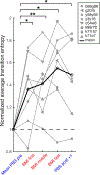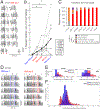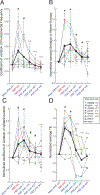Plasticity of stereotyped birdsong driven by chronic manipulation of cortical-basal ganglia activity
- PMID: 33974850
- PMCID: PMC8222193
- DOI: 10.1016/j.cub.2021.04.030
Plasticity of stereotyped birdsong driven by chronic manipulation of cortical-basal ganglia activity
Abstract
Cortical-basal ganglia (CBG) circuits are critical for motor learning and performance, and are a major site of pathology. In songbirds, a CBG circuit regulates moment-by-moment variability in song and also enables song plasticity. Studies have shown that variable burst firing in LMAN, the output nucleus of this CBG circuit, actively drives acute song variability, but whether and how LMAN drives long-lasting changes in song remains unclear. Here, we ask whether chronic pharmacological augmentation of LMAN bursting is sufficient to drive plasticity in birds singing stereotyped songs. We show that altered LMAN activity drives cumulative changes in acoustic structure, timing, and sequencing over multiple days, and induces repetitions and silent pauses reminiscent of human stuttering. Changes persisted when LMAN was subsequently inactivated, indicating plasticity in song motor regions. Following cessation of pharmacological treatment, acoustic features and song sequence gradually recovered to their baseline values over a period of days to weeks. Together, our findings show that augmented bursting in CBG circuitry drives plasticity in well-learned motor skills, and may inform treatments for basal ganglia movement disorders.
Keywords: basal ganglia; motor performance; motor variability; movement disorders; sequence variability; songbird; stuttering; vocal learning; vocal plasticity; zebra finch.
Copyright © 2021 The Authors. Published by Elsevier Inc. All rights reserved.
Conflict of interest statement
Declaration of interests The authors declare no competing interests.
Figures







Comment in
-
Basal ganglia: Bursting with song.Curr Biol. 2021 Jun 21;31(12):R791-R793. doi: 10.1016/j.cub.2021.04.064. Curr Biol. 2021. PMID: 34157263
Similar articles
-
Neurons in a forebrain nucleus required for vocal plasticity rapidly switch between precise firing and variable bursting depending on social context.J Neurosci. 2008 Dec 3;28(49):13232-47. doi: 10.1523/JNEUROSCI.2250-08.2008. J Neurosci. 2008. PMID: 19052215 Free PMC article.
-
Activity in a cortical-basal ganglia circuit for song is required for social context-dependent vocal variability.J Neurophysiol. 2010 Nov;104(5):2474-86. doi: 10.1152/jn.00977.2009. Epub 2010 Sep 8. J Neurophysiol. 2010. PMID: 20884763 Free PMC article.
-
Lesions of an avian basal ganglia circuit prevent context-dependent changes to song variability.J Neurophysiol. 2006 Sep;96(3):1441-55. doi: 10.1152/jn.01138.2005. Epub 2006 May 24. J Neurophysiol. 2006. PMID: 16723412
-
Variability in action: Contributions of a songbird cortical-basal ganglia circuit to vocal motor learning and control.Neuroscience. 2015 Jun 18;296:39-47. doi: 10.1016/j.neuroscience.2014.10.010. Epub 2014 Oct 18. Neuroscience. 2015. PMID: 25445191 Review.
-
Birdbrains could teach basal ganglia research a new song.Trends Neurosci. 2005 Jul;28(7):353-63. doi: 10.1016/j.tins.2005.05.005. Trends Neurosci. 2005. PMID: 15935486 Review.
Cited by
-
Stuttering: Our Current Knowledge, Research Opportunities, and Ways to Address Critical Gaps.Neurobiol Lang (Camb). 2025 Apr 2;6:nol_a_00162. doi: 10.1162/nol_a_00162. eCollection 2025. Neurobiol Lang (Camb). 2025. PMID: 40201450 Free PMC article. Review.
-
Androgen signaling in LMAN regulates song stereotypy in male canaries.Horm Behav. 2024 Sep;165:105611. doi: 10.1016/j.yhbeh.2024.105611. Epub 2024 Jul 31. Horm Behav. 2024. PMID: 39089160 Free PMC article.
-
Estradiol decreases the excitability of RA projection neurons in adult male zebra finches.Front Cell Neurosci. 2023 Feb 14;17:1046984. doi: 10.3389/fncel.2023.1046984. eCollection 2023. Front Cell Neurosci. 2023. PMID: 36866064 Free PMC article.
-
Neural circuit-wide analysis of changes to gene expression during deafening-induced birdsong destabilization.Elife. 2023 Jun 7;12:e85970. doi: 10.7554/eLife.85970. Elife. 2023. PMID: 37284822 Free PMC article.
-
Note similarities affect syntactic stability in zebra finches.J Comp Physiol A Neuroethol Sens Neural Behav Physiol. 2025 Jan;211(1):35-52. doi: 10.1007/s00359-024-01713-6. Epub 2024 Aug 12. J Comp Physiol A Neuroethol Sens Neural Behav Physiol. 2025. PMID: 39133335
References
-
- Kotz SA & Schwartze M (2010). Cortical speech processing unplugged: A timely subcortico-cortical framework. Trends Cogn. Sci. 14, 392–399. - PubMed
-
- Alm PA (2004). Stuttering and the basal ganglia circuits: A critical review of possible relations. J. Commun. Disord. 37, 325–369. - PubMed
-
- Ramig LO, Fox C & Sapir S (2008). Speech treatment for Parkinson’s disease. Expert Rev. Neurother. 8, 297–309. - PubMed
Publication types
MeSH terms
Grants and funding
LinkOut - more resources
Full Text Sources
Other Literature Sources
Research Materials
Miscellaneous

